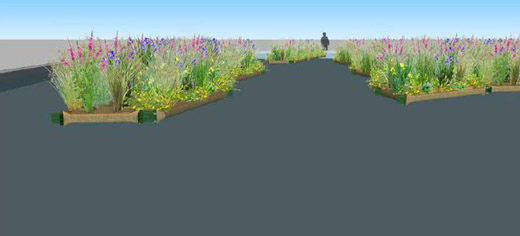Cool concept for Roger Stevens pond
Work has begun on an innovative project to improve the Roger Stevens cooling pond.
One of the floating ‘islands’ of plants. Picture courtesy of Biomatrix

Not only will this visually enhance the landscape outside the Roger Stevens Building, it will also provide research-led teaching opportunities for students.
The imaginative scheme – led by Estates Services – features floating ‘islands’ containing a range of plants to increase biodiversity and enable ecosystems to flourish.
Teams from across campus worked together to co-create a solution for the site, which also improves natural water quality and reduces operational costs.
The installation of sensors within the pool will also provide live data on water quality and a variety of environmental parameters, which will be made available to staff and students for interdisciplinary, research-led teaching.
Leonard Wilson, Deputy Director for Estates Services, said: “The scheme has been designed to create an extra ‘green’ dimension to this part of the campus and help biodiversity in the area.
“Once the planting has been established and the neutrality of the water is in balance, it is also hoped to introduce fish to the pond.
“The duck house will continue to remain at the pond side, and we envisage they, too, will benefit from the new, improved environment. We had two broods this year, which have now flown south, but we look forward to welcoming them back in the spring when the pool will be more established and flourishing.”

A computer-generated image of how the new pond will look
The Leeds Living Lab has also been involved in the project, in collaboration with colleagues from University-wide departments, including Sustainability and the Schools of Biology, Geography and Civil Engineering.
The Living Lab drives the University’s commitment to embedding sustainability through knowledge, engagement, collaboration and innovation. It brings together students, academic and operational staff to research and test sustainable solutions, enhance our curriculum and solve real world challenges using the University as a test-bed.
A Living Lab placement student in the School of Biology will ensure staff and students can access data for teaching and research use. And a new study has been launched into the effects of the water body on the ‘heat island effect’ of the surrounding architecture – the temperature discrepancy between cities and neighbouring rural areas created by the density of buildings.
With connections to Undergraduate and Postgraduate teaching modules in all the Schools involved, the collaborative approach has sought to ensure the pond can meet the demands of student-assessed projects, field practice and dissertations, whilst also delivering an innovative, sustainable solution as part of the University Landscape Strategy.
Work on the pond also comes days after the University officially opened its new sensory garden, adding further green space to campus.
Posted in: University news